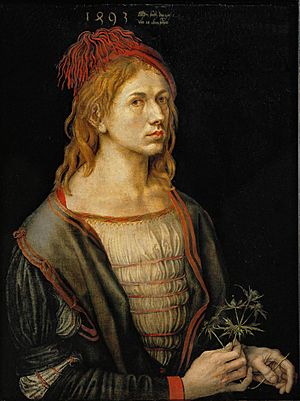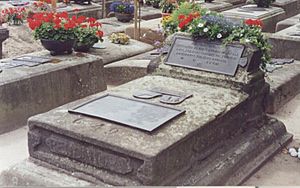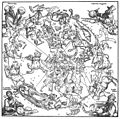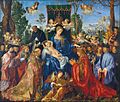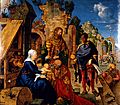Albrecht Dürer facts for kids
Quick facts for kids
Albrecht Dürer
|
|
|---|---|
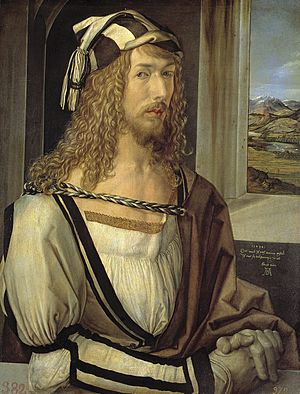
Dürer's self-portrait at 26
|
|
| Born | May 21, 1471 |
| Died | April 6, 1528 (aged 56) Nuremberg, Holy Roman Empire
|
| Nationality | German |
| Known for | |
| Movement | High Renaissance |
Albrecht Dürer (born May 21, 1471 – died April 6, 1528) was a famous German painter, engraver, and mathematician. He was born and passed away in Nuremberg, Germany. Dürer is most famous for his amazing old master prints.
His prints often came in a series, which means a group of different artworks about one main topic. These prints made him well-known all over Europe before he was even 30 years old. Many people consider him the greatest artist of the Renaissance in Northern Europe.
Albrecht Dürer is also known for inventing the basic idea behind ray tracing. This is a special technique used today in modern computer graphics to create realistic images.
Contents
Early Life of Albrecht Dürer
Albrecht Dürer was the third child of his parents. They had many children, between fourteen and eighteen in total! His father was a skilled goldsmith from a place called Ajtós, near Gyula in Hungary.
Dürer first learned goldsmithing and drawing from his father. But he was so talented at drawing that he started an apprenticeship at age fifteen in 1486. He trained with Michael Wolgemut, who was a top artist in Nuremberg at that time. Wolgemut had a big workshop that created many types of art, especially woodcuts for books.
Dürer's Travels and Family
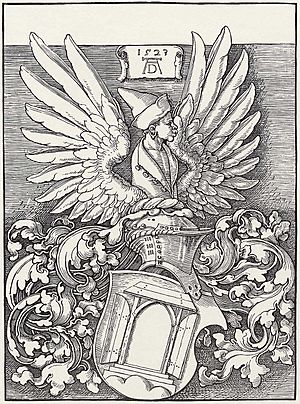
After finishing his training in 1489, Dürer traveled for four years. He explored Germany, Switzerland, and probably the Netherlands. He hoped to meet Martin Schongauer, who was known as the best engraver in Northern Europe. Sadly, Schongauer died just before Dürer arrived. Dürer stayed with Schongauer's brother and was able to get some of Schongauer's pictures.
Dürer painted his first self-portrait in Strasbourg. He likely sent it to his fiancée in Nuremberg. Soon after, he went back to Nuremberg to marry Agnes Frey on July 7, 1494. Agnes was the daughter of a well-known brass worker. Dürer and Agnes did not have any children, so the Dürer family name eventually ended.
In August 1494, a serious illness called the plague broke out in Nuremberg. This made the Dürers decide to leave the city. They traveled to Venice, Italy, where artists were using newer, more modern styles. Dürer wrote that Giovanni Bellini was the oldest and still the best artist in Venice.
Famous Artworks and Series
Dürer returned to Nuremberg in 1495 and opened his own art workshop. He stayed there for ten years. He started using more and more of what he learned in Italy. This made his art look very different from other Nuremberg artists who used only the old German style. During this time, he finished one of his most famous series, the Apocalypse (1498). This series included the famous woodcuts of the Four Horsemen of the Apocalypse (1497–1498).
Dürer made a second trip to Venice and stayed for two years. He came back to Nuremberg by mid-1507. He continued working on two more series about the suffering of Christ. These were the Great Passion (1498–1510) and the Little Passion (1510–1511). He also created his most famous individual engravings during this period: Knight, Death, and the Devil (1513), Saint Jerome in his Study (1514), and Melencolia I (1514). He painted many religious artworks and self-portraits using oils. He also made many beautiful watercolors and drawings. Dürer was friends with many important artists in Europe, and he even traded drawings with Raphael. He stayed in Germany until 1520.
Final Journeys and Illness
From 1520 to 1521, Dürer traveled to the Netherlands. He wanted to make sure he would have enough money for the rest of his life. His patron, Emperor Maximilian I, who had given him many jobs, had passed away. Dürer wanted to be sure the next emperor, Charles V, would continue to pay him for his art.
Back in Nuremberg, Dürer began working on a series of religious pictures. There are many practice sketches and studies (practice paintings for a bigger artwork) from this time. However, he didn't finish many large paintings. This was partly because he was ill. But it was also because he spent a lot of time getting ready to write books about geometry and how to show depth in art (perspective).
Dürer's Books on Art and Science
In his last years, Dürer started writing books. His book about geometry is called the Four Books on Measurement. In 1527, Dürer also published a book called Various Lessons on the Fortification of Cities, Castles, and Localities. This book was about how to build strong defenses for towns and castles. His work about human proportions is called the Four Books on Human Proportion, published in 1528.
-
Dürer often used multiview orthographic projections to show objects from different angles.
Death and Legacy
Albrecht Dürer died in Nuremberg when he was 56 years old. He left behind a large amount of money and goods, worth 6,874 florins. His art workshop was part of his big house. His widow lived there until she passed away in 1537. Today, Dürer's house is a museum that people can visit.
Interesting Facts About Albrecht Dürer
- The German name "Dürer" comes from the Hungarian word "Ajtósi." It first meant "Türer," which means doormaker. Albrecht Dürer later changed "Türer" to "Dürer" to fit the local way of speaking in Nuremberg.
- A door is even shown in his family's coat-of-arms.
- Dürer wrote about his own life, and he was famous by his mid-twenties. Because of this, we know a lot about his life.
- He was in touch with major Italian artists of his time. These included Raphael, Giovanni Bellini, and Leonardo da Vinci.
- From 1512, he received support from Emperor Maximilian I, who paid him for his art.
- Dürer worked with the court astronomer Johannes Stabius. In 1515, they made the first world map shown on a solid round shape. Also in 1515, Stabius, Dürer, and another astronomer named Konrad Heinfogel created the first flat maps of the stars for both the southern and northern hemispheres. These were the first printed celestial maps.
- One of Albrecht's brothers, Hans Dürer, was also a painter and learned from him.
- The Lutheran Church remembers Dürer every year on April 6. They also remember Michelangelo, Lucas Cranach the Elder, and Hans Burgkmair on this day.
Historical Stories About Dürer
- Dürer was very proud of being an artist. One day, his patron, Emperor Maximilian, was trying to sketch an idea with charcoal. But he kept breaking the charcoal. Dürer took the charcoal from Maximilian's hand, finished the drawing, and told him: "This is my scepter." (A scepter is a symbol of royal power.)
- Another time, Maximilian noticed that the ladder Dürer was using to paint a mural was too short and shaky. He told a noble person to hold the ladder for Dürer. The noble refused, saying it was below him to help someone who wasn't noble. Maximilian then came and held the ladder himself. He told the noble that he could make a noble out of a peasant any day. But he could not make an artist like Dürer out of a noble.
See Also
Images for kids
-
Self-portrait silverpoint drawing by the thirteen-year-old Dürer, 1484. It is at the Albertina, Vienna.
-
Portrait of Oswolt Krel, a merchant from Lindau (Lake Constance), 1499.
-
Albrecht Dürer's House in Nuremberg.
-
Adoration of the Magi (1504), an oil painting on wood at the Galleria degli Uffizi in Florence.
-
St Jerome in the Wilderness, 1495, oil on panel, at the National Gallery, London.
-
Detail from Haller Madonna, 1505, at the National Gallery of Art, Washington, D.C.
-
Albrecht Dürer the Elder with a Rosary, 1490, at the Galleria degli Uffizi, Florence.
-
Portrait of a Man, at the Prado Museum, Madrid.
-
Innsbruck Castle Courtyard, 1494, a Gouache and watercolour on paper.
-
Tuft of Cowslips, 1526, at the National Gallery of Art.
See also
 In Spanish: Alberto Durero para niños
In Spanish: Alberto Durero para niños


